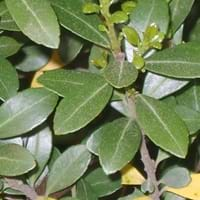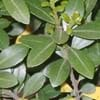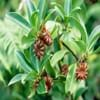Life Span
Perennial
Perennial
Type
Broadleaf Evergreen
Shrub
Origin
Eastern Asia
North America, United States, Northeastern United States, Mid-Atlantic United States, Southeastern United States, North-Central United States, South-Central United States, Texas
Types
Not Available
not available
Habitat
Well Drained, Woodland Garden Secondary, Woodlands
Boggy areas, Fens, Fields, meadows, Swamps, Woodlands
USDA Hardiness Zone
5-9
4-9
AHS Heat Zone
Not Available
8-4
Sunset Zone
21,22
1a, 1b, 2a, 2b, 3a, 3b, 4, 5, 6, 7
Habit
Oval or Rounded
Thicket/Colonizing
Flower Color
White, Light Green
Not Available
Flower Color Modifier
Bicolor
Not Available
Leaf Color in Spring
Green, Light Green, Dark Green
Not Available
Leaf Color in Summer
Dark Green
Not Available
Leaf Color in Fall
Dark Green
Not Available
Leaf Color in Winter
Dark Green
Not Available
Leaf Shape
Elliptic
Oblovate
Plant Season
Spring, Summer, Fall, Winter
Spring, Fall, Winter
Sunlight
Full Sun, Partial Sun, Partial shade
Full Sun, Partial Sun
Type of Soil
Clay, Loam
Clay, Loam
The pH of Soil
Acidic, Neutral
Acidic, Neutral, Alkaline
Soil Drainage
Well drained
Average
Bloom Time
Late Spring
Late Spring
Tolerances
Salt
Not Available
Where to Plant?
Ground
Ground, Pot
How to Plant?
Rooted stem cutting, Stem Cutting, stem tip cuttings
Divison, Seedlings
Plant Maintenance
Medium
Medium
Watering Requirements
Average Water Needs, Do not water frequently
Keep the ground moist but not water-logged
In Summer
Lots of watering
Lots of watering
In Spring
Moderate
Moderate
In Winter
Average Water
Average Water
Soil pH
Acidic, Neutral
Acidic, Neutral, Alkaline
Soil Type
Clay, Loam
Clay, Loam
Soil Drainage Capacity
Well drained
Average
Sun Exposure
Full Sun, Partial Sun, Partial shade
Full Sun, Partial Sun
Pruning
Remove damaged leaves, Remove dead branches, Remove dead leaves
Prune after flowering, Prune in early spring, Remove damaged leaves, Remove dead branches, Remove dead leaves
Fertilizers
All-Purpose Liquid Fertilizer, Apply N-P-K
All-Purpose Liquid Fertilizer, Compost, Fertilize every year, Mulch, Nitrogen
Pests and Diseases
Leafminers, Mites, Nematodes, Red blotch, Root rot, Tar spot
Aphids, Apple Maggot, Fall Webworm, Red blotch, Scale
Plant Tolerance
Drought, Full Sun
Not Available
Flowers
Insignificant
Showy
Flower Petal Number
Single
Not Available
Foliage Texture
Fine
Not Available
Foliage Sheen
Glossy
Not Available
Attracts
Bugs, Insects, Sawfly
Birds
Allergy
Not Available
Not Available
Aesthetic Uses
Beautification
Showy Purposes
Beauty Benefits
Not Available
Not Available
Environmental Uses
Air purification
Air purification
Medicinal Uses
Not Available
Not Available
Part of Plant Used
Leaves
Fruits
Other Uses
Not Available
Used As Food, Used as Ornamental plant
Used As Indoor Plant
No
No
Used As Outdoor Plant
Yes
Yes
Garden Design
Container, Edging, Foundation, Hedges, Mixed Border, Screening, Wind Break, Topiary, Bonsai, Espalier
Cutflower, Mixed Border, Screening, Wind Break
Botanical Name
ILEX crenata
ARONIA arbutifolia
Common Name
Box Leaved Holly
Beehive Japanese Holly
Red Chokeberry
In Hindi
Japanese Holly
लाल Chokeberry
In German
japanische Holly
Rote Apfelbeere
In French
houx japonais
Red Chokeberry
In Spanish
acebo japonés
rojo Chokeberry
In Greek
Ιαπωνικά Holly
κόκκινο Chokeberry
In Portuguese
Holly japonês
Red Chokeberry
In Polish
japoński Holly
Red aronii
In Latin
Holly Italica
arbutifolia
Phylum
Tracheophyta
Magnoliophyta
Class
Magnoliopsida
Magnoliopsida
Order
Aquifoliales
Rosales
Family
Aquifoliaceae
Rosaceae
Clade
Angiosperms, Asterids, Eudicots
Angiosperms, Eudicots, Rosids
Tribe
Not Available
Not Available
Subfamily
Not Available
Not Available
Number of Species
Not Available
Not Available
Season and Care of Japanese Holly and Red Chokeberry
Season and care of Japanese Holly and Red Chokeberry is important to know. While considering everything about Japanese Holly and Red Chokeberry Care, growing season is an essential factor. Japanese Holly season is Spring, Summer, Fall and Winter and Red Chokeberry season is Spring, Summer, Fall and Winter. The type of soil for Japanese Holly is Clay, Loam and for Red Chokeberry is Clay, Loam while the PH of soil for Japanese Holly is Acidic, Neutral and for Red Chokeberry is Acidic, Neutral, Alkaline.
Japanese Holly and Red Chokeberry Physical Information
Japanese Holly and Red Chokeberry physical information is very important for comparison. Japanese Holly height is 60.00 cm and width 60.00 cm whereas Red Chokeberry height is 180.00 cm and width 12.70 cm. The color specification of Japanese Holly and Red Chokeberry are as follows:
Japanese Holly flower color: White and Light Green
Japanese Holly leaf color: Green, Light Green and Dark Green
Red Chokeberry flower color: Not Available
- Red Chokeberry leaf color: Not Available
Care of Japanese Holly and Red Chokeberry
Care of Japanese Holly and Red Chokeberry include pruning, fertilizers, watering etc. Japanese Holly pruning is done Remove damaged leaves, Remove dead branches and Remove dead leaves and Red Chokeberry pruning is done Prune after flowering, Prune in early spring, Remove damaged leaves, Remove dead branches and Remove dead leaves. In summer Japanese Holly needs Lots of watering and in winter, it needs Average Water. Whereas, in summer Red Chokeberry needs Lots of watering and in winter, it needs Average Water.





